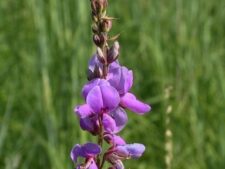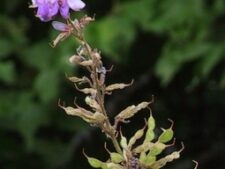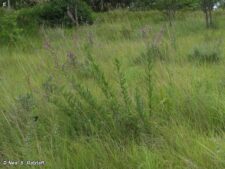
This native erect perennial usually grows 2-4 feet tall or more in good soils. The alternate, very short-stalked leaves are divided into 3 oval leaflets 2-4 inches long, the center leaflet longer than the others. Branching, gently curved flower stalks arise from the tip of the stem or leaf axils (A). They hold short-stalked elongate clusters (racemes) of pink to purple pea-like flowers about 1/2 inch long (B). Fruits are 3-5 segmented pods (loments) resembling a string of beads and covered with hooked hairs which stick to fur, clothing, shoestrings and hair of their unwitting dispersal agents (C).
Grows in moist to dry prairies, woodland edges, ditches and stream banks, flowering from July through September. At Neale Woods, it is uncommon in Nebraska and Jonas Prairies.
As one of the common names suggests, this is the showiest of our tickclovers. Larger, denser flower clusters and branched, gently curved flowering stems separate it from a similar species, Illinois Tickclover (D. illinoense), present in some of our local prairies but not yet documented at Neale Woods. It has smaller, more widely spaced flowers on an unbranched stem.
Tickclovers require insects for pollination and are considered good honey plants. These palatable plants are browsed by livestock and wildlife including the Neale Woods deer population.
Other common names include Showy Tick Trefoil and Beggar’s Ticks.
The content of NatureSearch is provided by dedicated volunteer Naturalists of Fontenelle Forest who strive to provide the most accurate information available. Contributors of the images retain their copyrights. The point of contact for this page is: Neal Ratzlaff.




